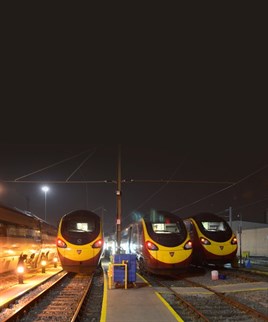Grundy looks at the ‘390s’ that have arrived. A board in the ‘Control Room’ lists what ‘390s’ are on site, and the work that they require. 390104 arrived at 0045 and is due off at 0422. That is the shortest downtime for any of the units. It had arrived early.
All ‘390s’ have their water replenished at Wembley, and Control Emission Toilets (CETs) emptied at most every two days. Each night across the depots 38 trains are worked on. Because of the intensity of the diagrams, if they go any longer, the CETs may get full, and so a ‘390’ loses its toilet facility.
Each night 12 Class 390s usually return to Wembley. Of the 12 on September 4, one (390155 X-Men Days of Future Past) was planned to run to Oxley the following night because of a number of faults. This meant that VT had lost a ‘390’, although it was still able to cope by using the spare set. At Wembley that night were 390009/011/042-044, 390104/112/121/135/155/157.
Swanson tells RAIL that Alstom’s ability to maintain the trains really does depend on the day. Because of the nature of the Very High Frequency (VHF) diagram that was introduced in 2008, the trains are intensively used, and it doesn’t take much of a delay to knock them out of sync.
“We are susceptible to Network Rail,” he acknowledges. “Virgin knows what maintenance capacity we have, and what we need to do.”
Grundy nods his head: “Alstom supplies 50 sets. There is one spare at Oxley. We have six on maintenance. Of those, one is undergoing an E/F or G exam, which is every 200,000 miles and takes three days. One is undergoing a D exam, which is every 100,000 miles and takes two days. Then there is also one undergoing a heavy repair at Longsight.”
There are also two sets (usually) that are ‘reliabilty sets’. These are normally ones that have experienced small problems, and Alstom engineers check everything. One of these trains is at Edge Hill, and the other at Oxley.
Grundy says that the next round of overhauls (H4) will begin next year. These will mimic the H1 overhauls, and for 390155-390157 it will be their first overhauls - 390154 has already been treated because it was already in use when its three new classmates were delivered.
There are also other exams (B and C) that are carried out every 20,000 miles, which equates to every 20 days. Grundy admits that the diagrams need balancing - for example, there cannot be ten ‘390s’ needing exams at the same time.
Grundy explains what happens when there are problems with the WCML: “Our best opportunity to get back on track is to step up at Euston , but that is not ideal as there is a tighter turnaround.”
Performance-wise, he says the ‘390s’ are recording an MTIN (miles per technical incident number) of 16,000-17,000 miles.
Swanson points out that, interestingly, all fleet performance dipped during the summer.
“There’s a variety of reasons, but not one major one,” he says. “The hot weather had an impact, but not massive. We can trace it to issues on the main line, as the delays to the depot don’t help.”
Grundy says that the Watford weekend closures are beneficial because it allows some ‘390s’ to be stood down for additional maintenance. He believes that should boost performance.
Swanson explains: “We need to know what is happening. Network Rail is coming on board now. It feels like there is ‘something’ there now that wasn’t before.”
Both suggest that NR is now more receptive to the operator’s concerns. “From a ‘390’ point of view we can plan, but we are at the mercy of the railway.”
Each depot that the ‘390s’ visit has a different role. For example, Oxley has a lot of staff who built the trains at Washwood Heath. Wembley is able to carry out air-conditioning unit overhauls. Longsight is the ‘mothership’ for the ‘390s’, and so gets the biggest repairs.
Swanson explains: “Every single day we review what has happened in the past 24 hours regarding fleet performance, and we talk about what we can do. It is a cycle. The exams come first. It is quite a challenge. It would be dead easy to say we want lots of time. But you just cannot do that.”
Could more be extracted from the ‘390s’, in terms of performance? Could they do even more work?
“I think we could get more from the ‘390s’,” says Grundy. “They could run for 24 hours a day. But what effect would that have on reliability? I think we are at the point where they can do as much as they can.
“The longer they run during the day, the less maintenance time there is. Take today. 390005 has failed with a Train Management System fault. That means we need to step up, but that affects capacity.
“You are balancing and looking at the long-term view. Sometimes we have to make the decision to cancel because it gives us breathing space. Ideally we’d look to knock out a London to Birmingham or Manchester, but you need to look at the train crew, or the set, to see where they need to be.”
The Pendolinos are, indeed, intensively worked. There is little scope for things to go wrong, and by 2025 the WCML will be at full capacity. The Pendolinos are keeping the UK’s premier main line running at full tilt, and their future is secure.
- This feature was originally published in RAIL 758 on 1 October 2014
















Login to comment
Comments
George - 02/04/2015 22:31
A great train! Have to say though, the interiors are starting to look a little tired (in my opinion of course) and I've never been a fan of the plastic trim. Many of the seat backs are covered in pen marks and scratches and could do with being replaced or cleaned. Obviously not necessarily Virgin's fault.